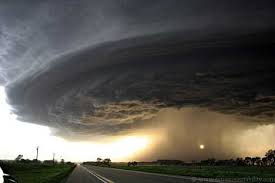Storm Chasers
There is something about a severe storm that transfixes the imagination. The high winds, swirling debris, and imposing mortal threat serve to fascinate. Storm chasers are some of those most fascinated by the power of a storm. The popularity and mainstream appeal of storm chasers began in the mid nineties with the film Twister, whose plot follows a group of tornado chasers as they risk more and more to track and chase bigger and bigger storms. Then came the Discovery Channel series Storm Chasers that, as the name suggest, follows a group of storm chasers on their chases. In the latter example, the storm chaser exits the fictional portrayal and becomes more real and tangible to the viewer.
Who Are Storm Chasers?
Storm chasers as a profession are most notable in their roles chasing tornadoes across the midwest, but many storm chasers frequent hurricane. flood, and wildfire affected areas as well–documenting and collecting data of the storms during and after. The individual storm chasers are typically adventure seeking, risk avert, and highly committed to gathering informative data and stunning photographs of storms up close. Many storm chasers are meteorologists who are essentially conducting prolonged fieldwork on storms. For tornado chasers, gathering data about the path of tornadoes, barometric pressure, wind velocity, and other information is essential to better understanding the storms and creating better warning systems.
The Art of the Chase
For professional storm chasers, a large portion of the job isn’t actually spent in hot pursuit of a storm–it is spent tracking and analyzing a storm. In order to do their jobs of collecting data and photos successfully–and safely, storm chasers must spend a lot of time tracking a storm on radar, analyzing it as it builds, and generally preparing a response. When it comes time for the chase, prior preparation, good instrumentation, and thorough analysis combine to make the outing worthwhile or not.
Storm chasers rely on their radar and other weather instruments to collect data about a storm and follow its path. They also rely on prior experiences and instincts to know how far they can push their luck and when to turn back. Storms can often act erratically and alter their course. For storm chasers embedded on the front lines of the storm, predicting, understanding, and foreseeing a storm’s movement can be the difference between life and death, or at least between getting good information and not. Beyond their cameras, instruments and instincts, the actual chase often comes down to a reliable vehicle, mental and physical endurance, and a fierce persistence to keep after a storm in miserable conditions. The art of the storm chase is characterized by a balance of obsessive planning and tempered pursuit. For the successful storm chaser, the mixture is the same.
Before you go out to give this hobby a try, consider the dangers. And if you have experienced a storm in a much more personal way, you can always call our storm damage restoration services to get you back on your feet and observing storms from a much safer distance.


